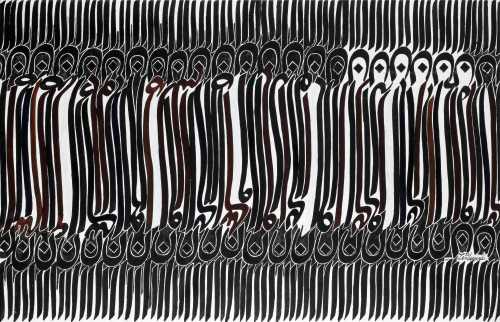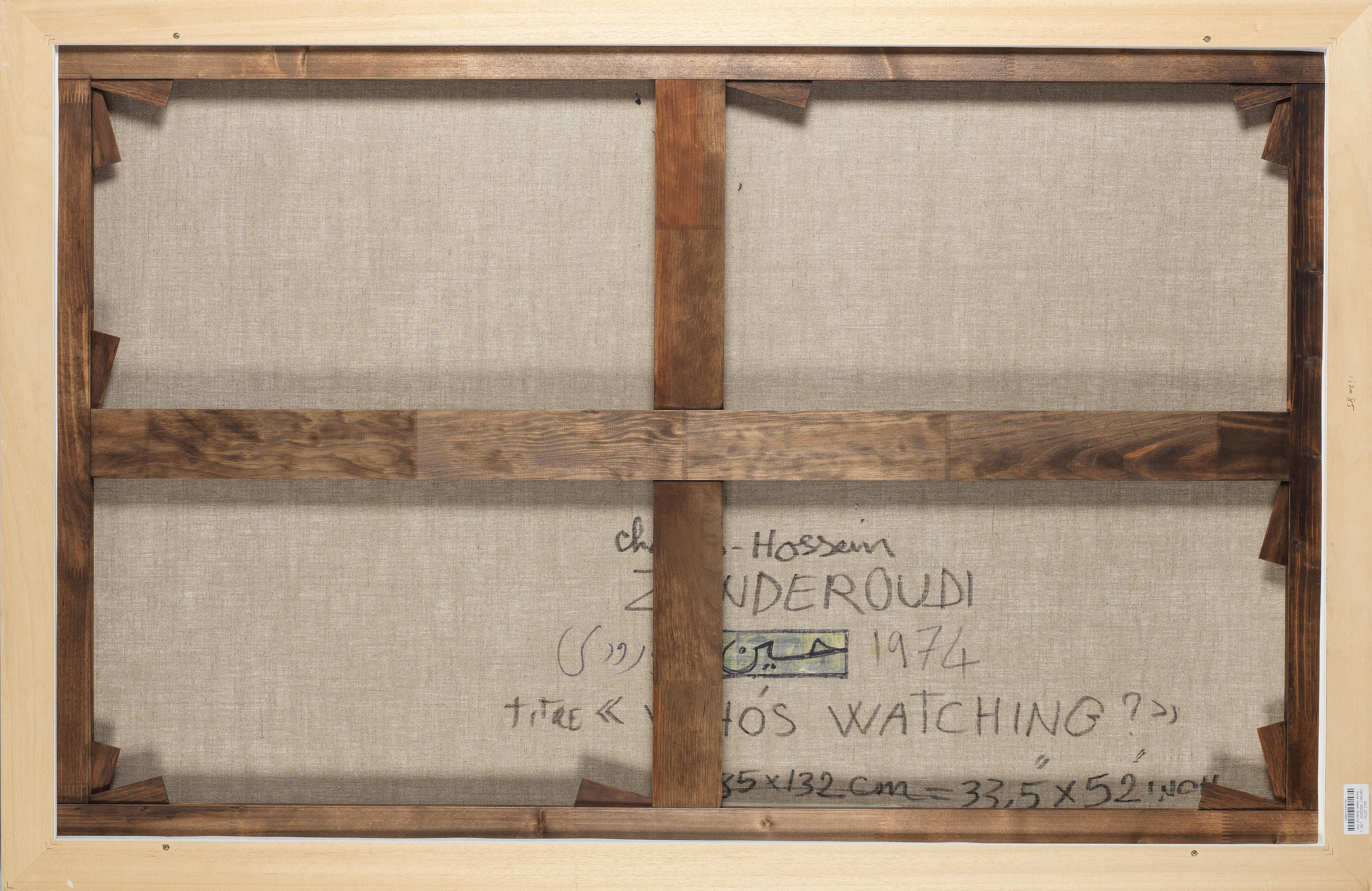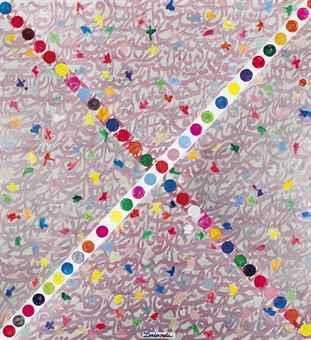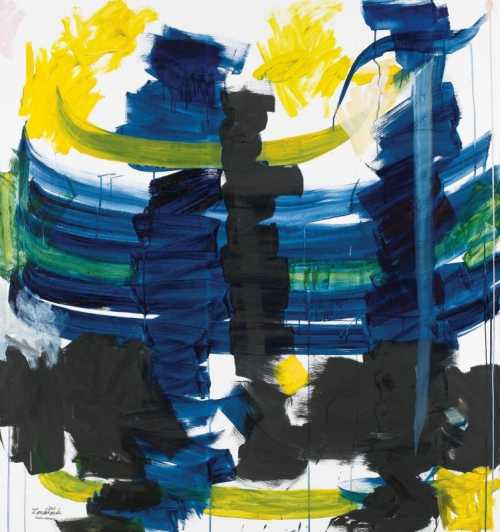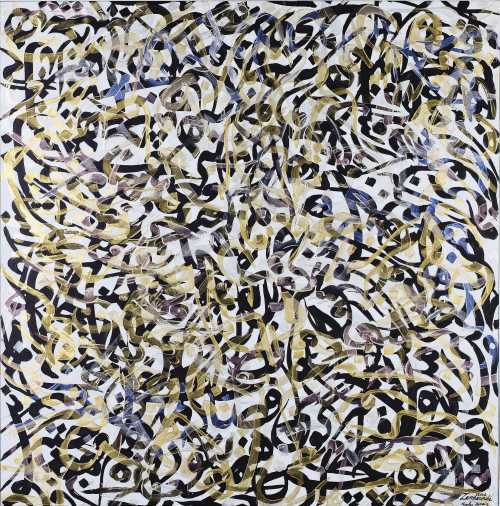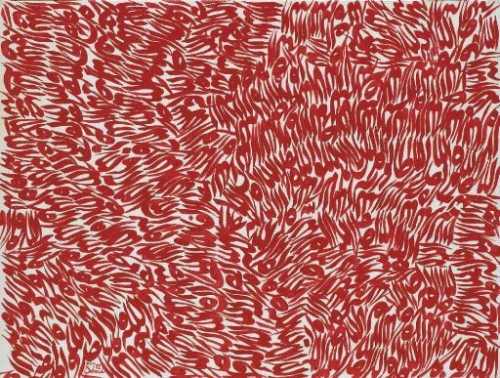- Who's Watching? 1974
- Oil on canvas
- Painting, Calligraphy Painting
- 132 * 85 cm
- Signed "Hossein Zenderoudi" and dated "74"
24 January 2024
Estimation
140,000,000,000﷼
280,000 USD
-
160,000,000,000﷼
320,000 USD
Realized Price
156,200,000,000﷼
312,400 USD
4.133%
Artwork Description
"To create a painting, I begin with the preliminary study, which consists of sketches on paper, followed immediately by the painting of letters and colouring on canvas... I am thus able to immediately express my spontaneous feelings on canvas. Sometimes I leave a canvas to work on another, this is like improvisation in music, for I treasure freedom more than anything else. I couldn't be what I am if I didn't have freedom to express my lyricism. I don't believe in teaching painting, since I do not believe that technical training is required to make one a great painter. Painting can be done with any tool or any piece of equipment, I believe all schools of fine art, all over the world, should be shut down"
Charles Hossein Zenderoudi is one of Iran's most accomplished modern artists, as a founding father Iranian neo-traditionalism Zenderoudi is a master of blending traditional Persian motif's within a distinctly avant-garde aesthetic.
His choice of subject matter, calligraphy, has historically been the most established mode of formal artistic expression prevalent in Iran, but, by emphasising form over meaning, and by stripping the written word down to its aesthetic, structural, fundaments, Zenderoudi subverts the traditional values of Persian calligraphy. Zenderoudi's text is intentionally illegible and carries no literal meaning, freeing it from the constraint of linguistic limitation, and imbuing it with a sense of universality which rescues the archaic practice of calligraphy from obscurity, giving it renewed relevance in a contemporary context.
Zenderoudi's compositions pay homage to centuries of Persian religious imagery and employ a systematic repetition of letter-forms that finds its genesis in the mystical practice of Sufi numerologists, who believed in the spiritual significance of singular letters and worked these principles into hugely intricate talismanic charts. Zenderoudi's methodical compositions, whilst not accurately following the grammar or axioms of numerology, capture the aesthetic and conceptual qualities of its cryptic nature.
Zenderoudi's early works focused on dense talismanic imagery, mixing iconography, freehand script and numerals. The density of these compositions sought to capture the visual intensity of popular religious expression in Iran, where banners, standards, altars, murals and mosques exuberantly adorn the urban landscape.
Works from the present series, composed in the 1970's, mark a shift towards a more avant-garde, patterned, technical and measured approach to calligraphy. The crowded iconography of the early works is replaced by a greater focus on singular and recurring letter-forms, which exhibit a formal refinement lacking in their earlier counterparts. The present work also marks a conceptual shift away from the more overtly traditional subject matters and more towards a pure, patterned aesthetic which emphasises the meditative and visual elements of letter depiction over their linguistic connotation.
Measured but spontaneous, technical yet effuse, Zenderoudi' manipulates Persian calligraphy with effortless ease, boasting a visual scope which faithfully captures the salient elements of Iran's traditional popular religious aesthetic. Rendered with the use of rich and vibrant colours, his canvases replicate the tonal and textural qualities of the votive art so common to the Iranian urban landscape.
Almost rhythmic in its grace, balance and composition, the present work is one of the finest examples of Zenderoudi's work from this period.
Charles Hossein Zenderoudi is one of Iran's most accomplished modern artists, as a founding father Iranian neo-traditionalism Zenderoudi is a master of blending traditional Persian motif's within a distinctly avant-garde aesthetic.
His choice of subject matter, calligraphy, has historically been the most established mode of formal artistic expression prevalent in Iran, but, by emphasising form over meaning, and by stripping the written word down to its aesthetic, structural, fundaments, Zenderoudi subverts the traditional values of Persian calligraphy. Zenderoudi's text is intentionally illegible and carries no literal meaning, freeing it from the constraint of linguistic limitation, and imbuing it with a sense of universality which rescues the archaic practice of calligraphy from obscurity, giving it renewed relevance in a contemporary context.
Zenderoudi's compositions pay homage to centuries of Persian religious imagery and employ a systematic repetition of letter-forms that finds its genesis in the mystical practice of Sufi numerologists, who believed in the spiritual significance of singular letters and worked these principles into hugely intricate talismanic charts. Zenderoudi's methodical compositions, whilst not accurately following the grammar or axioms of numerology, capture the aesthetic and conceptual qualities of its cryptic nature.
Zenderoudi's early works focused on dense talismanic imagery, mixing iconography, freehand script and numerals. The density of these compositions sought to capture the visual intensity of popular religious expression in Iran, where banners, standards, altars, murals and mosques exuberantly adorn the urban landscape.
Works from the present series, composed in the 1970's, mark a shift towards a more avant-garde, patterned, technical and measured approach to calligraphy. The crowded iconography of the early works is replaced by a greater focus on singular and recurring letter-forms, which exhibit a formal refinement lacking in their earlier counterparts. The present work also marks a conceptual shift away from the more overtly traditional subject matters and more towards a pure, patterned aesthetic which emphasises the meditative and visual elements of letter depiction over their linguistic connotation.
Measured but spontaneous, technical yet effuse, Zenderoudi' manipulates Persian calligraphy with effortless ease, boasting a visual scope which faithfully captures the salient elements of Iran's traditional popular religious aesthetic. Rendered with the use of rich and vibrant colours, his canvases replicate the tonal and textural qualities of the votive art so common to the Iranian urban landscape.
Almost rhythmic in its grace, balance and composition, the present work is one of the finest examples of Zenderoudi's work from this period.
Realized Price
100,337 USD
Min Estimate
60,720 USD
Max Estimate
84,601 USD
Average Artwork Worth
+63.951%
Average Growth of Artwork Worth
Sales Performance Against Estimates
Average & Median Sold Lot Value
2021 - 2025
Performance vs. Estimate
2021 - 2025
Sell-through Rate
2021 - 2025
